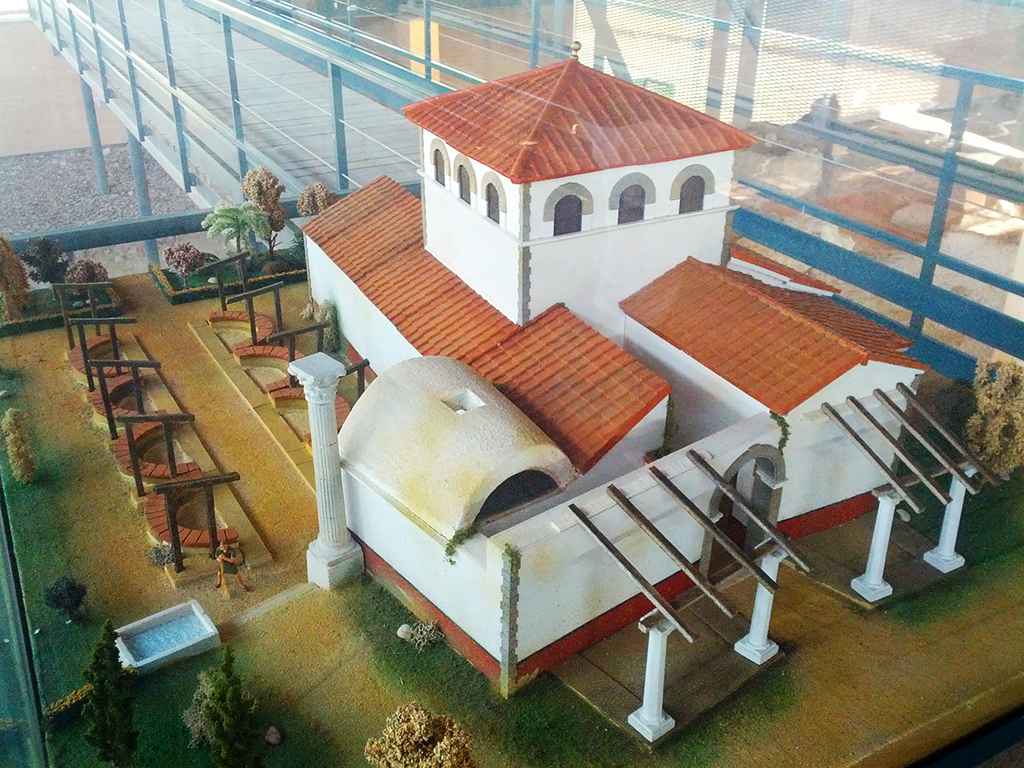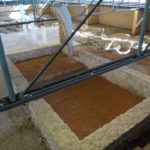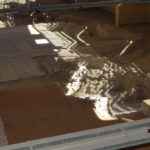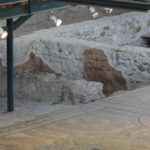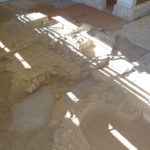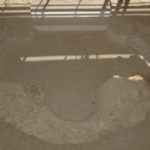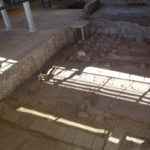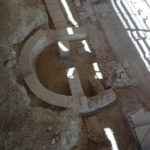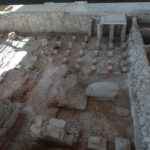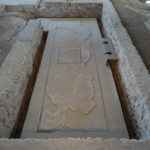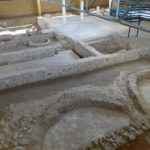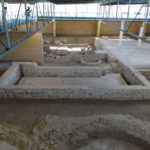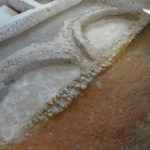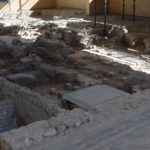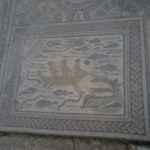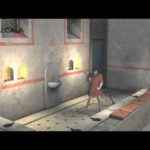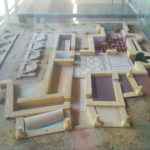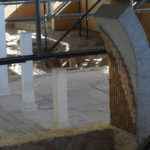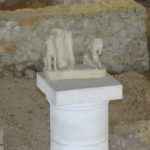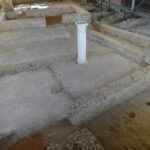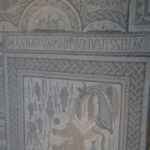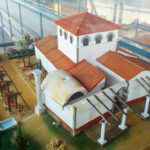Este texto también está disponible en español
Casa de Hippolytus is the first archaeological site of the Community of Madrid that was turned into a museum. Roman remains of the site—one of the best preserved of the region—were discovered in 1990 and able to visit in 1998.
Important discoveries in relation with Hispania were found decades ago among diverse excavations of the Roman city of Complutum. The most representative remain is Casa de Hippolytus, especially due to its mosaic and garden, also able to be visited since 1998.
Nor house, nor Hippolytus
Complutum, the most important Roman city of the center of the Iberian Peninsula at that time—two thousand years ago—, was so due to its strategic emplacement; in the middle of the way between Merida’s surroundings and the areas of Catalonia and Murcia, where huge Roman settlements’ were established. The road linking Emerita Augusta (Merida) and Caesar Augusta (Zaragoza) passed through Complutum, across today’s Camino del Juncal, in Alcalá.
The archaeological excavations—even though some started as early as the sixteenth century by members of Cisnerian Univerisity —started in a systematized way during the eighties. Abundant remains of that time have been found in Complutum, great part of which are hold on the Museo Arqueológico Regional, in Plaza de las Bernardas.
The most important settlement has indeed a very curious name, Casa de Hippolytus, even though the building was not a private home—but a Collegium Iuvenuma, school for young boys —and the property does not belong to any Hippolytus —who in fact was the author of the wonderful mosaic preserved in there.
The specialists who named the house did it after a tradition, that of relate the title with the most relevant elements of the excavation site content. It is thought that in the Pre-Roman period the construction set up in that place, probably devoted to a water deity, was buried under a Roman tavernae—shop or business premises—during the time of the emperor Claudius, first century after Christ.
However, in the middle of the third century after Christ, a deep reform was undertaken in order to raise the Colegio de Jóvenes, one of the few notable of Hispania.
School for Young Aristrocrats
The institution was supported by the rich family los Annios, who constructed their family mausoleum 100 meters distance from Casa de Hippolytus. The school was dedicated to the cultural and religious education and also included ludic and sportive activities for the children of the governing class of the city, the aristocracy. The young, in a wide sense, since the majority of them were teenagers; although some individuals within the preserved name lists were even forty years old.
The building was in a vast property in Complutum suburbs and housed large gardens, whose remains have today a huge historical value. Along with Pompeya’s, they are the only untouched gardens preserved from the Roman period.
The house was a school —one of the few safeguarded today— hosting young people until the end of the fourth century and beginning of the fifth, when it turned into a necropolis, with its own Christian church. Several tombs of that period have also been discovered. Many of the constructed areas had a vaulted roof, known thanks to the structure remains used by Romans to build them—some ceramic bottles bottomless, the tubuli fictile, fitting together and making up the arch.
Public Baths
Other notable remains are located in the public baths, with pools of varying temperature. The first containing lukewarm water—or tepidarium—, the second full of hot water—or caldarioum— and a third, of cold water, the only which is still open—or frigidarium. The baths, a very important social ritual for Romans, were used in such order. Constructed with a highly water-resistant material such as green grinded bricks; the heating and hot water comes from adjacent cauldrons sending heat through pipes under the floor, similar to current underfloor heating.
There was also a room dedicated to the worship of the goddess Diana Cazadora, surely surrounded by images of Hercules and by the genius of the Youth, the most common in such kind of religious places. Diana was a deity related with mineral waters, and, as Romans considered such waters medicinal, their relationship with the spirits of Nature was venerated through them. In Casa de Hippolytus, there is a well with great quantity of sulfates.
Oriental Garden
One of the most relevant parts of Casa de Hippolytus is its garden, Oriental in character. In other words, the garden followed the same style of those designed in the Near East at the same period, which were considered by Romans as the height of refinement. The seeds and pollen analysis has shown that there were pine trees, holm and oak trees, but also lime and cedar trees from Lebanon. There were as well date palms, canes, jasmines and other exotic species. Likely, aromatic and medicinal plants could be founded within the enclosure.
Notwithstanding, in that fantastic garden not only were exotic plants. It also has pigeons and pelicans, loose and put in a cage. All these whims incurred heavy expenses due to its foreign character; not autochthonous species had to be imported from distant lands as Egypt and Mesopotamia.
The garden was not just an amusement area; having an essential role into the school functioning: where classes were given. The exact place is well-preserved, preserving its parade-shape, with rows of semicircular long stone benches called exedras. They had a total capacity from eighty to a hundred sites, and were used for both debates and discourses, or meals. Besides, it was a pleasant place for chats and leisure for both students and teachers. They were covered by tarpaulin—secured in a lattice or wooden gates situated behind the rows of benches— providing a dense shadow and a quiet place for conversation.
The Sea Mosaic of Hippolytus
The great jewel of Casa de Hippolytus is precisely, the mosaic of Hippolytus master, an artist probably from north Africa. The mosaic is set up in the central garden were the frigidariums—or cold water pool—was situated. Inside the pool, it is represented a boat with three oarsmen surrounded of a great number of Mediterranean fish and mollusk, like octopus. morays, dolphins, sea urchins, red scorpion-fish and others. The image supposed an important didactical element, so you should not forget that students lived far away from the sea, in the middle of the plateau.
Latrines
Another well documented and recreated room from Casa de Hippolytus is the latrines. In a large and cared space, there are mosaics and seats—that could be built-in or made in marble—leaning against the door; and a water channel under them, by which the water runs to avoid unpleasant smells. They also constructed sinks for the toilet (as current washbasins), built with a variety of materials, probably marble, with heads and arms richly decorated. A curiosity incomprehensible for us, due to our current costumes, is that Romans went to relieve themselves to latrines in group, as it was considered a collective activity.
Every stay in Casa de Hippolytus is perfectly documented, allowing to visitors a very precise image of how their elements were and how was the life lived in there, transferring you back seven hundred years back in time and meeting Roman antecessors of the current Alcalá.
Additional Information:
Useful information:
- Address: Avenida Madrid, antigua nacional II, Km 28
- Teléfono: +34 91 881 32 50
Access from Madrid
- Renfe Cercanías railroads C-1, C-2 and C7A.
- Bus nº 223 (departure from Avenida de América Interchanger).
Opening hours
Summer (May to Sept.):
- Tue-Fri: from 10:00 a.m. to 2:00 p.m. (Monday closed)
- Sat and Sun: From 10:00 a.m. to 2:00 p.m. and from 5:00 p.m. to 8:00 p.m.
Winter (Oct to Apr.):
- Tue-Fri: from 10:00 a.m. to 2:00 p.m. (Monday closed)
- Sat and Sun: From 10:00 a.m. to 2:00 p.m. and from 4:00 p.m. to 7:00 p.m.
- Closed: Dec: 24, 25 and 31. Jan: 1 and 7
- Ticket price: 1 €
Image gallery:
On video:
Where is it
Sigue disfrutando de Dream Alcalá:
- Telegram: Recibe nuestras noticias y contenido exclusivo.
- Notificaciones: Da de alta o de baja las notificaciones en tu navegador.
- Newsletter: Recibe cada tarde un correo con nuestras últimas noticias.
- YouTube: Suscríbete para ver nuestros mejores vídeos.
 Sé tú el periodista: envíanos tus fotos o noticias a través de Telegram.
Sé tú el periodista: envíanos tus fotos o noticias a través de Telegram.

